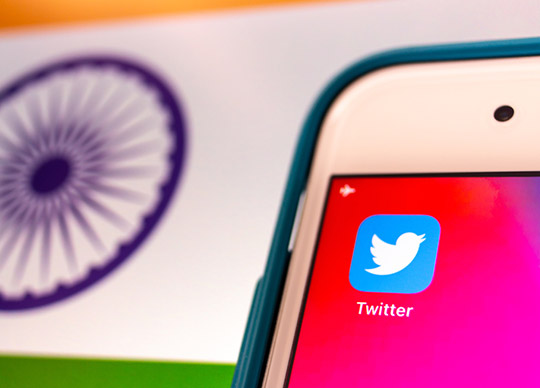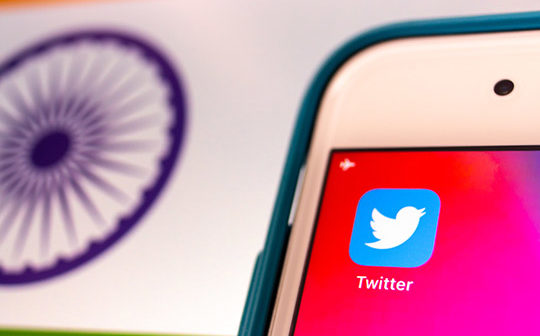
By Sarosh Bana, Mumbai Correspondent
Microblogging site Twitter appears to be treading a tightrope, as it brazens it out against an Indian government evidently intent on outlawing free speech on social media platforms.
While Google and Facebook are agreeable to complying with the new Information Technology (IT) (Intermediary Guidelines and Digital Media Ethics Code) Rules, 2021, which came into force on 26 May, Twitter is hedging, terming the government decision a “dangerous overreach that is inconsistent with open, democratic principles”. Curiously, Facebook-owned WhatsApp has taken the government to court over the issue.
The new rules empower the authorities to call out any post they deem inconvenient and thereby direct the social media intermediaries to track down the originator of the post by decrypting the message, that is, restoring the encrypted message to its original (readable) format. These technology multinationals have a policy of ensuring end-to-end encrypted messages so as to safeguard freedom of expression of their users. The government has moreover refused to exempt the digital news content of mainstream television channels and print media from the new IT Rules, and has instead urged immediate compliance by them.
As the government-Twitter standoff simmered, the Ministry of Electronics and IT (MeitY) sent Twitter a final notice, which noted that “your responses to the Ministry’s letters neither address the clarifications sought by this Ministry nor indicate full compliance with the rules”. The notice resulted in Twitter’s losing its intermediary status in India and becoming liable for users posting any content deemed ‘unlawful’ by the government.
The new IT rules also mandate each of these platforms to establish a local office manned by an India-based grievance officer, compliance officer and nodal contact person for liaising with law enforcement agencies and aggrieved users. This has caused much heartburn among the tech firms as they fear that a government intolerant of dissent and criticism could browbeat them into doing its bidding by blanking out a post and hunting down those behind it, or else it would hold their concerned executives personally liable.
This aspect was borne out by Twitter’s interim resident grievance officer Dharmendra Chatur, who on Sunday quit his post less than four weeks after being appointed to it. Chatur’s appointment had been flagged by MeitY as being violative of the new IT rules, as he was not on the company payroll. Twitter had recently informed the Ministry that it had appointed a nodal contact person and a resident grievance officer on a contractual basis, and was working to recruit people in these positions on a permanent basis. It had added that it was in the final stages of appointing a chief compliance officer and would soon be sharing details with the Ministry.
Though Twitter declined comment on the issue, Chatur’s name was deleted from the platform’s website. However, a day after he stepped down, Twitter indicated that its Global Legal Policy Director Jeremy Kessel would additionally serve as the new grievance officer for India. A tweet by Twitter noted: “Grievance Officer contact information for users in India. Twitter, Inc. c/o Jeremy Kessel, 1355 Market Street #900, San Francisco, California 94103, United States, grievance-officer-in@twitter.com.”
The government, however, did not recognise Kessel’s appointment, contending that it was not in line with the new IT rules that mandate that all nodal officials, including the grievance redressal officer, should be based out of India.
The government was not quite done with Twitter and already found an instance to evoke the new rules against it. The police of Ghaziabad in the northern state of Uttar Pradesh on 21 June summoned Twitter India Managing Director Manish Maheshwari – as also Chatur who was then still with Twitter – to be present at the police station for questioning at 10.30 am on 24 June. This was with regard to a video, which was circulating on other platforms like WhatsApp as well, that showed a 72-year-old Muslim man, Abdul Samad Saifi, being battered by six men and forced to chant the Hindu salutation “Jai Shri Ram”. The assailants also cut off his beard and forced him to watch videos of other Muslims being attacked.
Denying there was any communal angle to the assault, the Ghaziabad police claimed that the tweets on the video were “an attempt to destroy communal harmony”. They also sent a legal notice to Maheshwari in the case under laws related to incitement and criminal conspiracy. Among those the police arrested in the incident was a Muslim man who had videographed the assault on his cellphone. Maheshwari moved the court on the issue, and got relief when an order was passed restraining the Ghaziabad police from initiating any coercive action against him.
Maheshwari’s advocate submitted before the court that he was only an employee of Twitter, and was neither a board member nor responsible for uploading the video. He added that Maheshwari had informed the police of his willingness to join the investigation in virtual mode as he was based in Bengaluru, which lies 2,140 km from Ghaziabad, but the police insisted on a physical appearance. Besides, the police had framed such stringent charges against Maheshwari that cited him more as an accused than as a witness.
The new IT rules have been widely viewed in India as an additional ploy of the government to layer social media users with yet another shroud of mass surveillance, and benefiting the government at the cost of both the social media intermediaries and their users. Hence, Prime Minister Narendra Modi’s comments on 25 June – the 46th anniversary of the ‘Emergency’ declared in 1975 by the opposition Congress government – asking all Indians to “pledge to do everything possible to strengthen the democratic spirit and live up to the values enshrined in the Constitution” were greeted with much derision on social media.
Twitter and the government have consistently been at loggerheads, including during the farmers’ protests when support for the aggrieved farmers was trending across the social media. The microblogging platform had subsequently also tagged political posts of several ruling BJP party leaders against the Congress party as “manipulated media”, provoking a sharp rebuke from the government.
On 28 June, Twitter India displayed a map on its website that showed the sensitive border regions of Ladakh and Jammu and Kashmir as a separate country. The misrepresentation caused an uproar online that forced Twitter to pull down the map. MeitY announced that it would be having the issue investigated. Last October too, Twitter had inflamed sentiments in India with a geotag that showed Leh, the capital of Ladakh, as part of China. Incidentally, Chinese troops have overrun and occupied some 1,000 sq km in eastern Ladakh since May last year.
Another controversy erupted on news that Twitter CEO Jack Dorsey had donated $2.5 million of a total $15 million towards India’s efforts against the COVID-19 second wave, to an NGO called Sewa International. This NGO is said to be the American arm of Sewa Bharti, a welfare organisation affiliated with the Hindu right wing Rashtriya Swayamsevak Sangh (RSS), which is the ideological parent of the ruling BJP.
Adding to the furore was Twitter’s action on 25 June to block the accounts of both MeitY minister Ravi Shankar Prasad and Congress MP Shashi Tharoor, who also chairs the Parliamentary Standing Committee on IT and who had previously called Twitter executives to testify before the panel. Prasad shared snapshots of notices from Twitter, one of which informed that his handle had been blocked due to violation of the US’s Digital Millennium Copyright Act (DMCA). The accounts of both the politicians were subsequently reinstated.
Pointing out that his tweet had been deleted because it contained a video that Twitter observed had violated the copyrighted BoneyM song ‘Rasputin’, Tharoor later tweeted, “As Chairman of the Parliamentary Standing Committee on Information Technology, I can state that we will be seeking an explanation from @TwitterIndia for the locking of @rsprasad’s & my accounts & the rules & procedures they follow while operating in India.”
It is unclear why Twitter is riding a high horse when it is on a losing wicket against the Indian government. It is felt that the microblogging site would prefer to be seen as a victim if it is ousted from India, rather than voluntarily withdraw its service from the country. It might then be banking on an international outcry to facilitate its re-entry into India, a country where it enjoys its third highest number of users, 17.5 million, following the US’s 69.3 million and Japan’s 50.9 million, of a total 353 million monthly active users.






